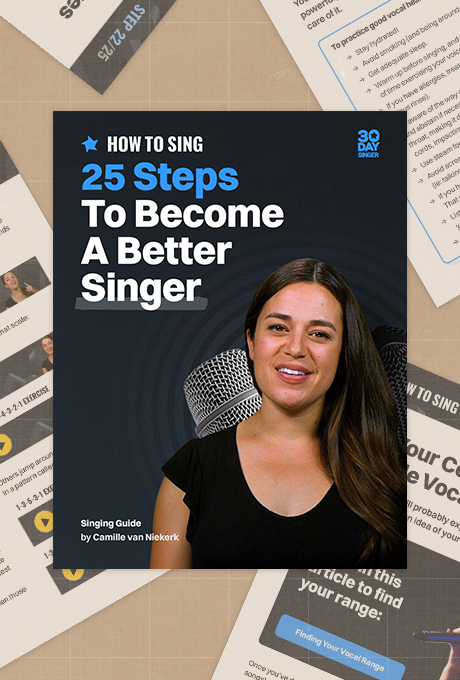Vocal fry is easier than you think
September 5, 2025Top 3 Takeaways
1) Vocal fry is a natural vocal register that sits below your speaking range and creates a creaky, buzzing tone.
2) It’s more than just a sound effect—fry can help strengthen vocal cord closure, improve onsets, and add style to your singing.
3) Simple exercises with words like “we” and “yeah” make it easy to explore vocal fry across your range.
What Is Vocal Fry?
Vocal fry is that low, crackly sound your voice makes when it relaxes at the very bottom of your range.
You may notice it when you’re tired or starting a sentence slowly.
It almost sounds like your vocal cords are buzzing together in slow motion.
But singers use vocal fry intentionally because it’s more than just a “creaky effect.”
It’s actually considered a distinct vocal register, sitting below your chest voice.
That makes it a valuable tool for both training and style.
How to Find Your Vocal Fry
The easiest way to discover your vocal fry is to drop your pitch as low as possible and let your voice fall into a relaxed creak.
Think of it like letting the air trickle out of your throat while your vocal cords gently vibrate.
Another trick is to imitate a door creaking open.
Go ahead and exaggerate it—the imitation often makes the right sound happen naturally.
Once you hear that buzz or crackle, you’ve found your fry.
Playing with the Fry
Once you’ve found the sound, spend a little time exploring it.
Sustain it: Hold a long fry tone and notice how little effort it takes.
Add pitch: Try moving slightly higher or lower in pitch while staying in fry.
Slide it: Move up and down slowly, keeping the creaky texture.
This step is about comfort - you want your vocal fry to feel relaxed, not forced.
Fry as an Onset
For most singers, vocal fry is most useful at the start of a note—this is called an onset.
The fry helps your vocal cords come together cleanly before you shift into normal singing.
Exercise: “We” Onset
1. Say “we,” letting the W buzz in fry.
2. Slide into the “ee” vowel smoothly.
3. Start around G2 or G3, then move step by step up and back down.
4. Keep it gentle and relaxed.
Exercise: “Yeah” Onset
1. Begin with the Y in fry.
2. Let it open into “ah” as you move into your singing tone.
3. Walk up and down through your range with the same approach.
These drills not only introduce you to fry, but they also build better cord closure if your voice tends to sound airy.
Why Singers Use Vocal Fry
Vocal fry has two main roles:
Stylistic: You’ll hear it in Pop, R&B, Country, and even Rock singing. Used sparingly, it adds grit, character, and a conversational tone.
Technical: Fry helps with vocal cord and singing strength. If your voice feels weak or breathy, practicing fry onsets can train your cords to connect more firmly.
Because it’s easy on the voice when done correctly, fry can be both a warm-up tool and a stylistic flourish.
Wrapping It Up
Vocal fry is one of those techniques you already know instinctively—you’ve probably used it without realizing.
The difference now is learning to control it and apply it in your singing.
Start by finding the creaky sound, experiment with slides, and then try the “we” and “yeah” exercises.
Over time, you’ll find fry becomes a flexible tool you can use for both style and strength.
FAQ: Vocal Fry in Singing
Is vocal fry bad for your voice?
When used gently, vocal fry is safe and even beneficial. Problems only occur if you push too hard or stay in fry for extended periods.
What does vocal fry sound like?
It’s a low, creaky, buzzing tone—like a door creaking open or a gravelly “uhh” sound.
Can vocal fry help my singing voice?
Yes. It improves vocal cord closure, which can strengthen weak or airy singing. It also helps develop controlled onsets for cleaner notes.
Why do pop singers use vocal fry?
Many singers use fry stylistically because it adds grit, attitude, and a conversational feel at the start of phrases.
How do I practice vocal fry safely?
Start relaxed, don’t force volume, and keep sessions short. Use fry as a gentle exercise, then return to normal singing.


